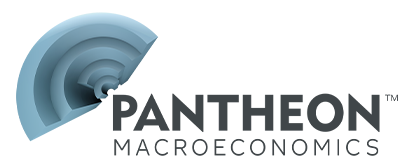Pantheon Publications
Below is a list of our Publications for the last 5 months. If you are looking for reports older than 6 months please email info@pantheonmacro.com, or contact your account rep.
Please use the filters on the right to search for a specific date or topic.
Samuel Tombs
- Lower immigration, AI, tariffs and federal job cuts have potential to lift the natural unemployment rate...
- ...But firms are filling openings more easily and plan to slow wage growth, pointing to excess unemployment.
- No signs of excessive unemployment by state or by sector, indicative of a still-low equilibrium rate.
- Investors see a near-90% chance of the FOMC easing next week, back to levels before October’s meeting.
- Sometimes, the Chair moves markets during the blackout via the WSJ, but that seems unlikely now.
- Manufacturing payrolls have fallen materially in 2025, but likely aren’t a canary in the coalmine this time.
- The average effective tariff rate is currently just 12%, far short of the near-20% widely expected in spring.
- China imports have dived; more imports than expected from Canada and Mexico are USMCA-compliant.
- The plunge in the Cass Freight Index looks alarming, but it probably is overstating weakness in industry.
Core PCE inflation set to undershoot the FOMC’s forecast in Q4.
- PPI and CPI data imply the core PCE deflator rose by just 0.22% in September.
- Goods price rises are slowing and retailers, especially auto retailers, are still partially absorbing the tariffs.
- The Conference Board’s consumer survey implies the labor market need more support from the FOMC.
- We look for a subpar 0.3% increase in September retail sales, consistent with real spending edging down.
- Food service sales likely fell sharply, while the more reliable indicators of control sales were soft.
- Bloomberg Second Measure data, Google search volumes and hotel room occupancy signal a weak Q4.
- Growth in average hourly earnings is resilient because fewer entry level workers are being hired...
- ...Rising unemployment, the low quits rate and a wide range of surveys all point to an underlying slowdown.
- The NY Fed’s Williams still sees room to ease policy “...in the near term”, bolstering our December call.
- In one line: Payrolls flattered by the seasonals; rising unemployment keeps a December easing in play.
Payrolls flattered by the seasonals; rising unemployment keeps a December easing in play.
- The pick-up in payrolls was a by-product of the most generous September seasonal on record...
- ...The chances of a downward revision are very high; October’s report will be substantially weaker too.
- The rise in the unemployment rate is being fuelled by new entrants and layoffs; expect more to come in Q4.
- The BLS’ new data calendar means today’s employment report is make-or-break for a December easing.
- The GDPNow model is running a bit too hot; GDP growth in Q3 of about 31/2% seems more likely.
- October’s jump in WARN filings is due to new laws in Washington state; the trend is rising moderately.
- We expect a 50K increase in September payrolls and a 75K rise in private jobs, lifted by residual seasonality.
- The unemployment rate usually drops in September, but surveys point to a deteriorating trend.
- Growth in average hourly earnings likely was limited by a calendar quirk, but the trend is slowing too.
- AI has had a net positive impact on the labor market this year; job losses in tech have been small...
- ...While surging stock prices for AI firms have boosted households’ spending and, therefore, employment.
- Layoffs, however, likely will step up next year as AI adoption becomes more widespread.
- Retailers usually pass on the bulk of any cost increases to consumers, but bank most of any savings.
- Retailers won’t cut prices only to hike them again if the White House reimposes tariffs via other routes.
- The AI stock sell-off is small so far, but a deeper rout would have a tangible impact on GDP growth.
- Markets now see an even chance of a December rate cut, after a volley of hawkish Fed speeches...
- ...But no one has changed their view from September, and the official data will support the doves.
- Tinkering with tariffs on food would have only a very small impact on overall inflation.
- The October CPI probably will never be released, but indicators point to a mere 0.2% rise in the core.
- Pass-through from tariffs to goods prices appears to have slowed; vehicle prices still largely unaffected.
- Residual seasonality, lower health insurers’ margins and fading rent rises imply slower services inflation.
- Continuing claims are rising only gradually, but understate the recent increase in labor market slack.
- Federal staff who took deferred resignation offers are ineligible to claim; new graduates can’t claim either.
- Capex intentions have improved lately, but remain consistent with weak underlying investment.
- Comparing November’s UoM survey to its historical range overstates the depth of consumer gloom...
- ...But the massive deterioration in major purchase plans this year is too big to simply brush aside.
- Small businesses are bearing down on wage growth; pay rises of just 3% will be the norm next year.
- The relationship between Challenger job cut announcements and actual layoffs has loosened lately...
- ...WARN filings are a better leading indicator; they also rose in October, but to a smaller extent.
- We agree with the consensus that break-even payroll growth is about 50K, but for first estimates its 100K.
- Goods exports are struggling, as foreign firms run down the inventory they amassed earlier this year.
- Services exports are flailing too, despite strong demand for software; US politics has put off tourists.
- Data centre construction is surging, but it is too small to provide much a of boost to the sector at large.
